
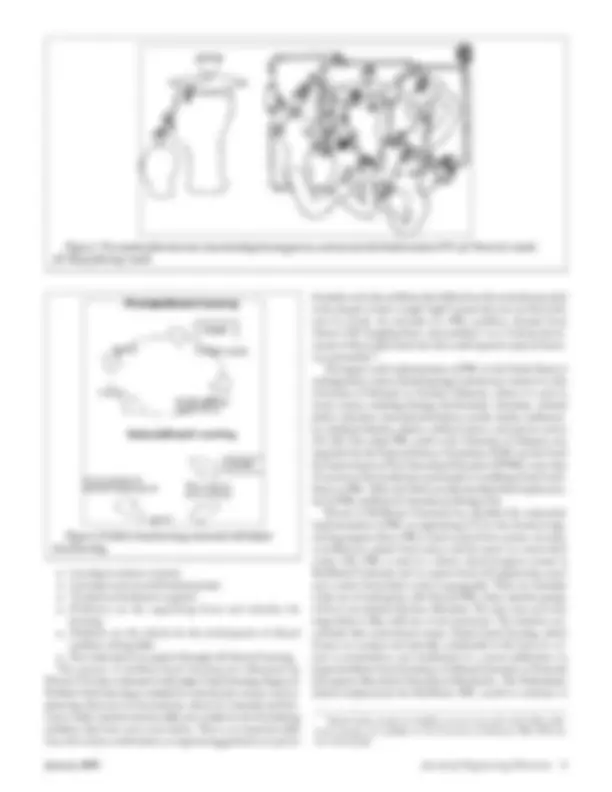


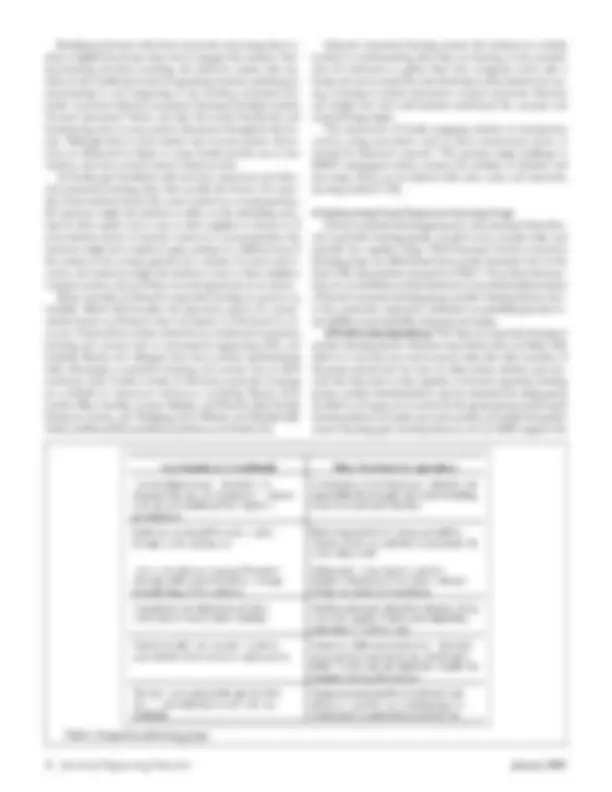
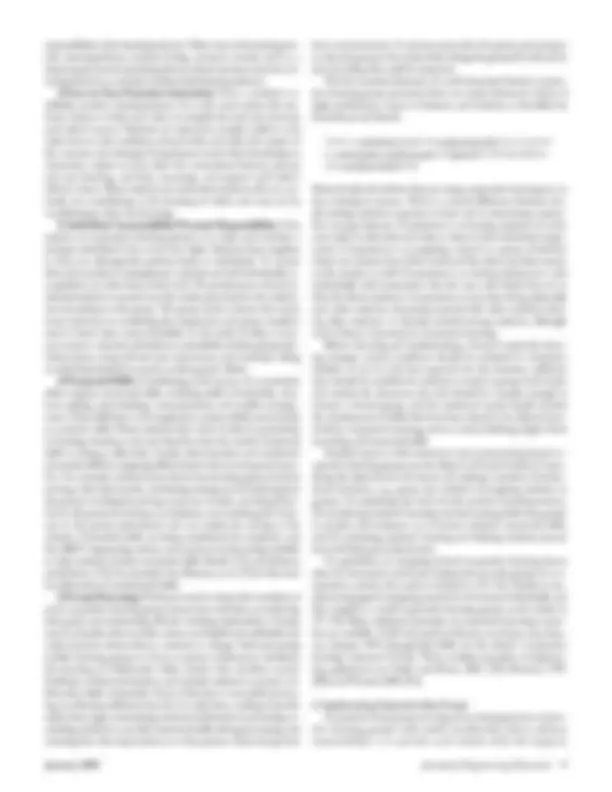
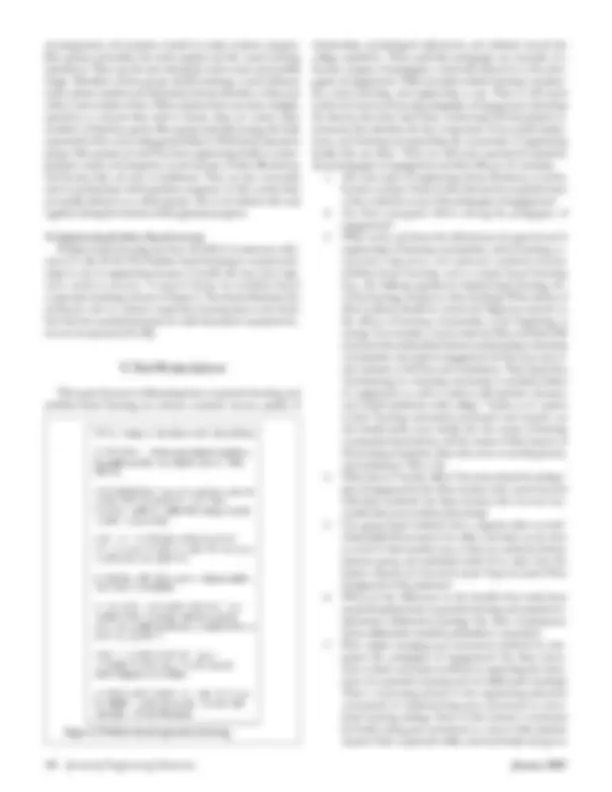

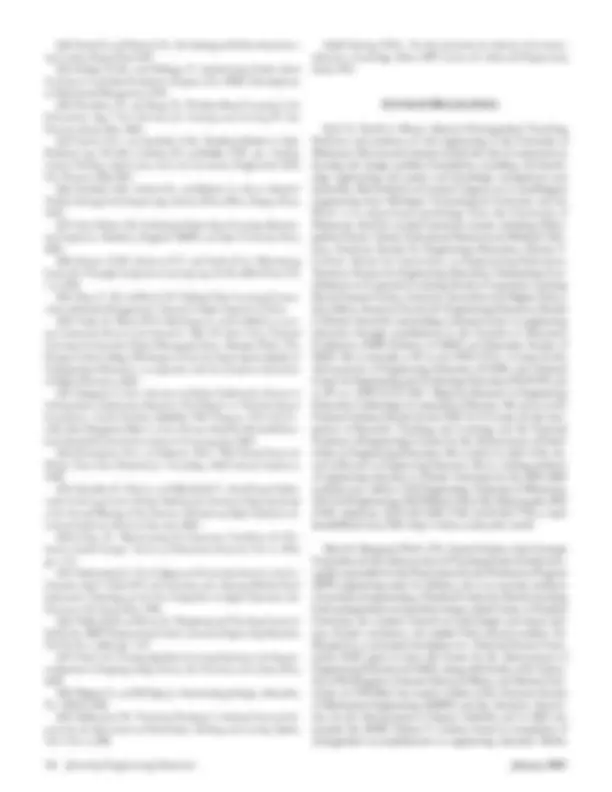



Study with the several resources on Docsity

Earn points by helping other students or get them with a premium plan


Prepare for your exams
Study with the several resources on Docsity

Earn points to download
Earn points by helping other students or get them with a premium plan
Community
Ask the community for help and clear up your study doubts
Discover the best universities in your country according to Docsity users
Free resources
Download our free guides on studying techniques, anxiety management strategies, and thesis advice from Docsity tutors
The implementation of various means to better engage undergraduate engineering students, with a focus on cooperative learning and problem-based learning. the principles of pedagogies of engagement, the history and benefits of cooperative learning, and the essential elements for successful implementation of formal cooperative learning groups. The document also touches upon other student engagement strategies such as learning communities, service learning, and inquiry-based learning.
What you will learn
Typology: Summaries
1 / 15

This page cannot be seen from the preview
Don't miss anything!










Department of Civil Engineering University of Minnesota
Department of Mechanical Engineering Stanford University
Department of Educational Psychology
Department of Curriculum and Instruction University of Minnesota
Educators, researchers, and policy makers have advocated student involvement for some time as an essential aspect of meaningful learning. In the past twenty years engineering educators have implemented several means of better engaging their undergraduate students, including active and cooperative learning, learning communities, service learning, cooperative education, inquiry and problem-based learning, and team projects. This paper focuses on classroom-based pedagogies of engagement, particularly cooperative and problem-based learning. It includes a brief history, theoretical roots, research support, summary of practices, and suggestions for redesigning engineering classes and programs to include more student engagement. The paper also lays out the research ahead for advancing pedagogies aimed at more fully enhancing students’ involvement in their learning.
Keywords: cooperative learning, problem-based learning, student engagement
Russ Edgerton introduced the term “pedagogies of engage ment” in his 2001 Education White Paper [1], in which he reflected on the projects on higher education funded by the Pew Charitable Trusts. He wrote:
“Throughout the whole enterprise, the core issue, in my view, is the mode of teaching and learning that is practiced. Learning ‘about’ things does not enable students to acquire the abilities and understanding they will need for the twenty-first century. We need new pedagogies of engagement that will turn out the kinds of resourceful, engaged workers and citizens that America now requires.”
Prior to Edgerton’s paper, the widely distributed and influential publication called The Seven Principles for Good Practice in Undergraduate Education [2] stressed pedagogies of engagement in concept. Three of the principles speak directly to pedagogies of engagement, namely, that good practice encourages student-faculty contact, co operation among students, and active learning. More recently, the project titled The National Survey of Stu dent Engagement (NSSE) [3] deepens our understanding of how students perceive classroom-based learning, in all its forms, as an el ement in the bigger issue of student engagement in their college ed ucation. The NSSE project conceives that student engagement is not just a single course in a student’s academic career, but rather a pattern of his or her involvement in a variety of activities. As such, NSSE findings are a valuable assessment tool for colleges and uni versities to track how successful their academic practices are in en gaging their student bodies. The NSSE project is grounded in the proposition that student engagement, the frequency with which students participate in activities that represent effective educational practice, is a meaningful proxy for collegiate quality and, therefore, by extension, quality of education. For example, the annual survey of freshmen and seniors asks students how often they have partici pated in, for example, projects that required integrating ideas or in formation from various sources, used e-mail to communicate with an instructor, asked questions in class or contributed to class discus sions, received prompt feedback from faculty on their academic performance, participated in community-based projects, or tutored or taught other students. Student responses are organized around five benchmarks:
January 2005 Journal of Engineering Education 1
studied, including the curriculum content factors. This result indi cates that how students approach their general education and how the faculty actually deliver the curriculum is more important than the formal curriculum, that is, the content, collection, and sequence of courses. The assessment study by Light [5, 6] of Harvard students strongly suggests that one of the crucial factors in the educational development of the undergraduate is the degree to which the stu dent is actively engaged or involved in the undergraduate experience; this is consistent with Astin’s work [4]. Astin and Light’s research studies suggest that curricular planning efforts will reap much greater payoffs in terms of student outcomes if more emphasis is placed on pedagogy and other features of the delivery system , as well as on the broader interpersonal and institutional context in which learning takes place. Pascarella and Terenzini’s summary of twenty years of research on the impact college has on student development further supports the importance of student engagement:
“Perhaps the strongest conclusion that can be made is the least surprising. Simply put, the greater the student’s involvement or engagement in acad emic work or in the academic experience of college, the greater his or her level of knowledge acquisition and general cognitive development… If the level of involvement were totally determined by individual student motivation, interest, and ability, the above conclusion would be uninter esting as well as unsurprising. However, a substantial amount of evi dence indicates that there are instructional and programmatic interven tions that not only increase a student’s active engagement in learning and academic work but also enhance knowledge acquisition and some dimen sions of both cognitive and psychosocial change” [7].
Macgregor, Cooper, Smith, and Robinson [8] provided a syn thesis of interviews conducted with forty-eight individuals teaching undergraduate classes across the United States who are infusing their large classes with small-group activities or are working explic itly to create student communities within large classes. The faculty who were interviewed are working with classes of more than 100 students, and some are teaching substantially larger classes, in the 350 to 600 student range. The faculty practicing small-group learn ing in large classes provided extensive empirical and theoretical ra tionale for their practices. Their reasons clustered in the following categories:
evidence for effectiveness (section IV), and offer model practices for implementation (section V). The paper concludes by presenting some unanswered questions about classroom-based pedagogies of engagement for engineering in particular and pedagogies in general.
“To teach is to engage students in learning.” This quote, from Education for Judgment by Christensen et al. [9], captures the essence of the state of the art and practice of pedagogies of engagement. The thesis of this book, and this paper, is that engaging students in learning is principally the responsibility of the teacher, who be comes less an imparter of knowledge and more a designer and facili tator of learning experiences and opportunities. In other words, the real challenge in college teaching is not covering the material for the students; it’s uncovering the material with the students. Consider the most common model of the classroom-based teaching and learning process used in engineering education in the past fifty years (and maybe currently?). This model, illustrated in Figure 1(a), is a presentational model where, as one pundit quipped, “the information passes from the notes of the professor to the notes of the students without passing through the mind of either one.” An alternative to the “pour it in” model is the “keep it flowing around” model. This is shown in Figure 1(b) and illustrates that the information passes not only from teacher to student, but also from students to teacher and among the students. The model of teaching and learning represented in Figure 1(b) emphasizes that the simultaneous presence of interdependence and accountability are essential to learning, and their presence is at the heart of a student-engaged instructional approach. The model of the teaching-learning process in Figure 1(b) is predicated on cooperation—working together to accomplish shared goals. Within cooperative activities individuals seek outcomes that are beneficial to themselves and beneficial to all other group mem bers. Cooperative learning is the instructional use of small groups so that students work together to maximize their own and each others’ learning [10, 11]. Carefully structured cooperative learning involves people working in teams to accomplish a common goal, under con ditions that involve both positive interdependence (all members must cooperate to complete the task) and individual and group accountability (each member individually as well as all members collectively ac countable for the work of the group). Astin [12] reported that 14 percent of engineering faculty and 27 percent of all faculty said they used cooperative learning in most or all of their classes. A common question is, “What is the difference between cooper ative and collaborative learning?” Both pedagogies are aimed at “marshalling peer group influence to focus on intellectual and sub stantive concerns” [13]. Their primary difference is that cooperative learning requires carefully structured individual accountability, while collaborative does not. Numerous authors, such as Barkley, Cross, and Major [14], use the term collaborative learning to refer to predominantly cooperative learning research and practice. To try to minimize confusion, we will use the term cooperative learning throughout the current paper. Problem-based learning (PBL) “is the learning that results from the process of working toward the understanding or resolution of a problem. The problem is encountered first in the learning process” [15]. Barrows [16] identified six core features of PBL:
2 Journal of Engineering Education January 2005
1974), and at universities in Australia. There is an excellent summary of these programs in PBL Insight [23]. A comparison of problem- based and project-based learning is available in Mills and Treagust [24]. Project-based learning, which is often the basis for the senior design courses in undergraduate engineering curriculum in the United States, will not be further discussed in this paper; the reader is referred to the work of Dym et al. [25]. Lest the reader think that the model of the teaching-learning process illustrated in Figure 1(b) is a modern creation, consider the long and rich history of the practical use of pedagogies of engage ment, especially classroom-based practices such as cooperative learning and problem-based learning. Thousands of years ago the Talmud stated that to understand the Talmud , one must have a learn ing partner. Confucius is typically credited with the Chinese proverb “Tell me and I forget; show me and I remember; involve me and I understand.” (However, Edgerton [1] and others attribute the Lakota Sioux Indians). The Roman philosopher, Seneca, advocated cooperative learning through such statements as, “Qui Docet Dis cet” (when you teach, you learn twice). J. Amos Comenius (1592–1679) believed that students would benefit both by teaching and by being taught by other students. In the late 1700s, J. Lancast er and A. Bell made extensive use of cooperative learning groups in England and India, and the idea was brought to the America when a Lancastrian school was opened in New York City in 1806 [26]. One of the more successful advocates of cooperative learning in the United States was Colonel Francis Parker [27] in the late 1800s. Parker started several schools and hosted many visitors to his schools who in turn started or changed their own programs. In the last three decades of the nineteenth century, Colonel Parker advo cated cooperative learning with enthusiasm, idealism, practicality, and an intense devotion to freedom, democracy, and individuality in the public schools. Following Parker, John Dewey promoted the use of cooperative learning groups as part of his famous project method in instruction [28]. John Dewey’s ideal school involved ● a “thinking” curriculum aimed at deep understanding; ● cooperative learning within communities of learners; ● interdisciplinary and multidisciplinary curricula; and ● projects, portfolios, and other “alternative assessments” that challenged students to integrate ideas and demonstrate their capabilities. In the late 1930s, however, public schools began to emphasize interpersonal competition and this view predominated for well over forty years [29]. In the mid-1960s Johnson and Johnson began training K- teachers and a few post-secondary teachers how to use cooperative learning at the University of Minnesota. The Cooperative Learning Center at the University of Minnesota resulted from their efforts to (a) synthesize existing knowledge concerning cooperative, competi tive, and individualistic efforts, (b) formulate theoretical models concerning the nature of cooperation and its essential elements, (c) conduct a systematic program of research to test the theorizing, (d) translate the validated theory into a set of concrete strategies and procedures for using cooperative learning, and (e) build and main tain a network of schools implementing cooperative strategies and procedures throughout the world. From being relatively unknown and unused in the 1960s, cooperative learning is now an accepted and often the preferred instructional procedure at all levels of educa tion throughout the world in every subject area and from preschool through graduate school and adult training programs [30].
Most of the work on developing and researching models of coop erative learning in the 1970s and 1980s focused on K-12 education. For example, in the early 1970s DeVries and Edwards [31] at Johns Hopkins University developed Teams-Games-Tourna ments (TGT) and the Sharans in Israel developed the group in vestigation procedure for cooperative learning groups [32]. In the late 1970s Slavin and colleagues at Johns Hopkins University extended DeVries and Edwards’ work by modifying TGT into Student-Teams-Achievement-Divisions (STAD) and modifying computer-assisted instruction into Team-Assisted Instruction (TAI) [32]. Concurrently, Kagan [34] developed cooperative learn ing structures that involved detailed procedures, such as numbered heads together. This was followed in the 1980s by Cohen develop ing a “complex instruction” version of cooperative learning [35, 36] and Dansereau [37] developing a number of cooperative learning scripts. The 1980s and 1990s brought an expansion of cooperative learning models into engineering. The concept of a cooperative learning group was introduced to the engineering education com munity at the 1981 IEEE/ASEE Frontiers in Education (FIE) conference in Rapid City, S.D. [38]. Goldstein also presented a paper on cooperative learning at this conference and Goldstein and Smith were subsequently invited to present a workshop (probably the first) on cooperative learning at the 1982 FIE con ference. Also, in 1981 the first in a series of papers on cooperative learning was published in Engineering Education , “Structuring learning goals to meet the goals of engineering education” [10]. In the mid-1990s the Foundation Coalition embraced the cooperative learning approach, produced several one-page sum maries of concepts, and developed an extensive Web site on Active/Cooperative Learning: Best Practices in Engineering Education.^2 More recently, Millis and Cottell [39] adapted Kagan’s coopera tive learning structures for higher education faculty, and Johnson, Johnson, and Smith began adapting the conceptual cooperative learning model to higher education [40–42].
The underling precept of cooperative and problem-based learn ing is interdependence. The term interdependence was introduced by Coleridge in 1822 and is defined, according to the Oxford English Dictionary , as “The fact or condition of depending each upon the other; mutual dependence.” Many of the early references to the term, e.g., by Coleridge, Huxley, Spencer, were biology related. Spencer introduced the “conception of [society] as having a natural structure in which all its institutions, governmental, religious, in dustrial, commercial, etc., etc., are inter-dependently bound” ( Ox ford English Dictionary ) Research on cooperative learning has been guided primarily by social interdependence theory. The theory was conceived of in the early 1900s, when one of the founders of the Gestalt School of Psy chology, Kafka, proposed that groups were dynamic wholes in which interdependence among members could vary. One of his col leagues, Lewin [43], refined Kafka’s notions in the 1920s and 1930s while stating that (a) the essence of a group is the interdependence
(^2) See http://clte.asu.edu/active.
4 Journal of Engineering Education January 2005
among members (created by common goals) that results in the group’s being a “dynamic whole” so that a change in the state of any member or subgroup changes the state of all other member or sub group and (b) an intrinsic state of tension within group members motivates movement toward the accomplishments of the desired common goals. One of Lewin’s graduate students, Deutsch, formu lated the theory of cooperation and competition in the late 1940s [44, 45]. One of Deutsch’s graduate students, D. Johnson (collabo rating with R. Johnson), extended Deutsch’s work into classroom practices [46–48]. The social interdependence perspective assumes that the way so cial interdependence is structured determines how individuals in teract, which in turn determines outcomes. Positive interdepen dence (cooperation) results in promotive interaction as individuals encourage and facilitate each other’s efforts to learn. Negative inter dependence (competition) typically results in oppositional interac tion as individuals discourage and obstruct each other’s efforts to achieve. In the absence of interdependence (individualistic efforts), there is no interaction as individuals work independently without any interchange with each other [44]. Extensive research has been conducted on cooperative learn ing—defined in section II as the instructional use of small groups so that students work together to maximize their own and each others’ learning. From 1897 to 1989 nearly 600 experimental and more than 100 correlational studies were conducted comparing the effec tiveness of cooperative, competitive, and individualistic efforts in promoting learning. Before 1970, almost all the reported studies were conducted in college classrooms and laboratories using college students as participants. The U.S. experimental research on cooper ative learning has its roots in Deutsch’s work in the late 1940s in a study at MIT [49]. Between 1970 and 1990 the majority of the studies were conducted in K-12 settings; however, in the 1990s, the interest in investigating the use of cooperative learning at the college level was rekindled. Current meta-analysis work at the Cooperative Learning Center at the University of Minnesota identified 754 studies that compare the effectiveness of students working cooperatively, competitively, and individualistically from 1897 to the present. Eighty five percent were conducted since 1970; 43.5 percent had randomly assigned subjects and 18.8 percent had randomly assigned groups; 41.4 per cent of the subjects were nineteen or older; 76.7 percent were pub lished in a journal; 31 percent were laboratory studies and 65 per cent were field studies [30]. These studies and others yet to be coded will be analyzed in the coming months. The next two sections summarize the research on cooperative learning and problem-based learning at the post-secondary level, that is, the studies of higher education and adult populations.
A. Cooperative Learning Research Approximately 305 studies were located at the Cooperative Learn ing Center and were used to compare the relative efficacy of coopera tive, competitive, and individualistic learning in college and adult set tings, as reported in [41, 42]. The first of these studies was conducted in 1924; 68 percent of the studies have been conducted since 1970. Sixty percent randomly assigned subjects to conditions, 49 percent consisted of only one session, and 82 percent were published in jour nals. These 305 studies form the research summarized below. The multiple outcomes can be classified into three major cate gories: academic success, quality of relationships, and psychological
adjustment to college life. In addition, there are a number of studies on students’ attitudes toward the college experience. 1) Academic Success: One of the most important goals for en gineering educators is that students succeed academically. Academ ic success is, above all, the college’s aim and the student’s aim. Be tween 1924 and 1997, more than168 rigorous research studies were conducted comparing the relative efficacy of cooperative, competi tive, and individualistic learning on the achievement of individuals eighteen and older. This represents the subset of the 305 studies that focus on individual student acheivement. Other studies focused on students’ attitudes, persistence (or retention), and other depen dent measures. These studies indicate that cooperative learning promotes higher individual achievement than do competitive ap proaches or individualistic ones. The effect sizes, which indicate the magnitude of significance, were 0.49 and 0.53 for competitive and individualistic approaches, respectively. Effect sizes of this magni tude indicate significant, substantial increases in achievement. They can be interpreted as saying, for example, that college students who would score at the fiftieth percentile level on an individual exam when learning competitively will score in the sixty-ninth percentile when learning cooperatively; students who would score at the fifty- third percentile level when learning individualistically will score in the seventieth percentile when learning cooperatively [41]. For a briefing on the meta-analysis procedure see [49]. The relevant measures here include knowledge acquisition, re tention, accuracy, creativity in problem solving, and higher-level reasoning. The results hold for verbal tasks (such as reading, writ ing, and oral presentations), mathematical tasks, and procedural tasks (such as laboratory exercises). There are also other subsets of the 305 studies showing significant advantages for cooperative learning in promoting meta-cognitive thought, willingness to take on difficult tasks, persistence (despite difficulties) in working to ward goal accomplishment, intrinsic motivation, transfer of learn ing from one situation to another, and greater time spent on task. The findings outlined above are consistent with results from a recent meta-analysis focused on college level-one science, mathe matics, engineering, and technology (SMET) courses. Springer, Stanne, and Donovan’s [49] study of small-group (predominantly cooperative) learning in SMET courses identified 383 reports from 1980 or later, thirty-nine of which met the rigorous inclusion crite ria for meta-analysis. Of the thirty-nine studies analyzed, thirty- seven (94.9 percent) presented data on achievement, nine (23.1 per cent) on persistence or retention, and eleven (28.2 percent) on attitudes. The main effect of small-group learning among under graduates majoring in SMET disciplines was significant and posi tive, with mean effect sizes for achievement, persistence, and atti tudes of 0.51, 0.46, and 0.55, respectively. Recent synthesis publications include Bowen’s [50] summary of research on cooperative learning effects on chemistry and Prince’s [51] summary of research on active and cooperative learning in engineering. Research that has had a significant influence on the instructional practices of engineering faculty is Hake’s [52] comparison of stu dents’ scores on the physics Force Concept Inventory (FCI), a mea sure of students’ conceptual understanding of mechanics, in tradi tional lecture courses and interactive engagement courses. The results shown for high school (HS), college (COLL), and university (UNIV) students in Figure 3 show that student-student interaction during class time is associated with a greater percent gain on the
January 2005 Journal of Engineering Education 5
colleges and countries. Research participants have varied with re- spect to economic class, age, sex, nationality, and cultural back- ground. The researchers have employed a wide variety of tasks, sub- ject areas, methods of structuring cooperative learning, and methods of measuring dependent variables, and methodologies. The volume and diversity of the research is almost unparalleled in educational re- search.
B. Problem-Based Learning Research Problem-based learning is undergoing a renaissance in profes- sional education, including engineering education [57], as well as research on PBL. PBL is not a new idea; it had its beginnings in 1968 in the M.D. program at McMaster University in Hamilton, Ontario, Canada. McMaster graduated its first PBL class in 1972. At about the same time the College of Human Medicine at Michigan State University implemented a problem-based program [58]. Problem-based learning expanded to other disciplines besides medicine at the University of Maastricht (which implemented the McMaster PBL model in medicine in 1974) and to all majors at Aalborg University. Dochy, Segers, Van den Bossche, and Gijbels [59] provided an excellent and recent meta-analysis of PBL research, predominantly in medicine. They selected forty-three studies according to the fol- lowing inclusion criteria (page 536):
Of the three key aspects of cooperative learning and problem- based learning—theory, research, and practice—the practice piece
is the least developed and probably the most difficult. The classroom practices involved with cooperative learning and problem-based learning are complex to both design and implement, as well as to manage during the term. The NSF Foundation Coalition has ac- tively focused on implementing active and cooperative learning for several years, including developing print materials, an extensive Web site, and a CD-ROM to support implementation.^3 In spite of these implementation efforts and many others, cooperative learning and problem-based learning are not widely practiced in engineering classrooms. Part of the reason may be not only the difficulty of de- signing, implementing, and managing such a program, but also that most faculty did not experience any form of cooperative or problem- based learning during their undergraduate (or graduate) education. We remain hopeful, however, that the use of these pedagogies will continue to expand, not only because they are they effective, but also because there are many ways to implement them in engineering. In this section we highlight some well-developed and honed prac- tices. Informal cooperative learning groups (often referred to as ac- tive learning), formal cooperative learning groups, and cooperative base groups are the most commonly implemented by engineering faculty. Each provides opportunities for students to be intellectually active and personally interactive both in and outside the classroom. Informal cooperative learning is commonly used in predominately lecture classes and is described only briefly. Formal cooperative learning can be used in content intensive classes where the mastery of conceptual or procedural material is essential; however, many faculty find it easier to start in recitation or laboratory sections or design pro- ject courses. Base groups are long-term cooperative learning groups whose principal responsibility is to provide support and encourage- ment for all their members; that is, to ensure that each member gets the help he or she needs to be successful in the course and in college.
A. Implementing Informal Cooperative (Active) Learning Informal cooperative learning consists of having students work together to achieve a joint learning goal in temporary, ad-hoc groups that last from a few minutes to one class period [41]. Informal coop- erative learning groups also ensure that misconceptions, incorrect understanding, and gaps in understanding are identified and correct- ed, and that learning experiences are personalized. In one instance of informal cooperative learning students are asked every ten to fifteen minutes to discuss what they are learning (see Figure 4).
January 2005 Journal of Engineering Education 7
(^3) See http://clte.asu.edu/active.
Figure 4. Bookends on a class session.
Breaking up lectures with short cooperative processing times re- sults in slightly less lecture time, but re-engages the students. Dur- ing lecturing and direct teaching, the instructor ensures that stu- dents do the intellectual work of organizing material, explaining it, summarizing it, and integrating it into existing conceptual net- works. Common informal cooperative learning techniques include “focused discussions” before and after the lecture (bookends) and interspersing turn-to-your-partner discussions throughout the lec- ture. Although three to four minute turn-to-your-partner discus- sions are illustrated in Figure 4, many faculty provide one to two minutes, and some can be as short as thirty seconds. As faculty gain familiarity with real-time assessment and infor- mal cooperative learning, they often modify the format. For exam- ple, if most students choose the correct answer to a concept question, the instructor might ask students to reflect on the underlying ratio- nale for their answer and to turn to their neighbor to discuss it. If most students choose an incorrect answer to a concept question, the instructor might try to explain it again, perhaps in a different way. If the answers to the concept question are a mixture of correct and in- correct, the instructor might ask students to turn to their neighbor, compare answers, and see if they can reach agreement on an answer. Many examples of informal cooperative learning in practice are available. Mazur [63] describes the interactive aspects of a ninety- minute lecture on Newton’s laws in Chapter 5 of his book Peer In- struction. Darmofal has written about his use of informal cooperative learning and concept tests in aeronautical engineering [64], and similarly Martin and colleagues have been actively experimenting with information cooperative learning and concept tests in fluid mechanics [65]. Further details of informal cooperative learning are available in numerous references, including Mazur [63], Landis, Ellis, Lisensky, Lorenz, Meeker, and Wamser [66], Novak, Patterson, Garvin, and Wolfgang [67], Michael and Modell [68], Felder and Brent [69], and Johnson, Johnson, and Smith [41].
Informal cooperative learning ensures that students are actively involved in understanding what they are learning. It also provides time for instructors to gather their wits, reorganize notes, take a break, and move around the class listening to what students are say- ing. Listening to student discussions can give instructors direction and insight into how well students understand the concepts and material being taught. The importance of faculty engaging students in introductory courses, using procedures such as those summarized above, is stressed by Seymour’s research: “The greatest single challenge to SMET pedagogical reform remains the problem of whether and how large classes can be infused with more active and interactive learning methods” [70].
B. Implementing Formal Cooperative Learning Groups Formal cooperative learning groups are more structured than infor- mal cooperative learning groups, are given more complex tasks, and typically stay together longer. Well-structured formal cooperative learning groups are differentiated from poorly structured ones on the basis of the characteristics presented in Table 1. From these character- istics we can distill five essential elements to successful implementation of formal cooperative learning groups: positive interdependence, face- to-face promotive interaction, individual accountability/personal re- sponsibility, teamwork skills, and group processing. 1) Positive Interdependence: The heart of cooperative learning is positive interdependence. Students must believe they are linked with others in a way that one cannot succeed unless the other members of the group succeed and vice versa. In other words, students must per- ceive that they sink or swim together. In formal cooperative learning groups, positive interdependence may by structured by asking group members to (1) agree on an answer for the group (group product-goal interdependence), (2) make sure each member can explain the groups’ answer (learning goal interdependence), and (3) fulfill assigned role
8 Journal of Engineering Education January 2005
Table 1. Comparison of learning groups.
encouragement, and assistance needed to make academic progress. Base groups personalize the work required and the course learning experiences. They stay the same during the entire course and possibly longer. Members of base groups should exchange e-mail addresses and/or phone numbers and information about schedules, as they may wish to meet outside of class. When students have successes, insights, questions, or concerns they wish to discuss, they can contact other members of their base group. Base groups typically manage the daily paperwork of the course using group folders or Web-based discussion groups. Base groups are used by many engineering faculty in under- graduate courses and programs, in part because of their effectiveness and because they are easy to implement. They are also commonly used in professional school graduate programs. In this context they are usually referred to as cohort groups : five to six students who stay together during the duration of their graduate program.
D. Implementing Problem-Based Learning Problem-based learning has been described in numerous refer- ences [17, 20, 59, 82–87]. Problem-based learning is a natural tech- nique to use in engineering because it models the way most engi- neers work in practice. A typical format for problem-based cooperative learning is shown in Figure 5. The format illustrates the professor’s role in a formal cooperative learning lesson and shows how the five essential elements of a well-structured cooperative les- son are incorporated [41, 88].
This paper focused on illustrating how cooperative learning and problem-based learning can advance academic success, quality of
relationships, psychological adjustment, and attitudes toward the college experience. These particular pedagogies are examples of a broader category of pedagogies, commonly referred to as the peda- gogies of engagement. Other examples include learning communi- ties, service learning, and engineering co-ops. There is still much work to be done in advancing pedagogies of engagement: extending the theories that form their basis, conducting well-formulated ex- periments that elucidate the key components of successful deploy- ment, and fostering and expanding the community of engineering faculty who use them. There are still many unanswered questions about pedagogies of engagement and their efficacy. For example,
10 Journal of Engineering Education January 2005
Figure 5. Problem-based cooperative learning.
a way to reduce the number of “free-loaders” on a cooperative team, and some by faculty seeing it as a way to incorporate ac tual work contribution in awarding individual grades on a team project. In addition, the ABET engineering criterion that says engineering graduates will have demonstrated an “ability to function on multidisciplinary teams” is motivating some engineering programs to conceive of peer assessment as a way of demonstrating this ability. Little is known about how peer assessment affects the nature of the cooperative work itself; research is sorely needed to study this influence, as outlined in a recent NSF report authored by Sheppard et al. [91]. The work of Eschenbach [92], Cohen [93], and Schaeffer et al. [94] are examples of this type of research
The research findings on pedagogies of engagement outlined in this paper, along with student engagement data available through NSSE, underscore former University of Michigan President (and professor of nuclear engineering) James Duderstadt’s call for action:
“It could well be that faculty members of the twenty-first century college or university will find it necessary to set aside their roles as teachers and instead become designers of learning experiences, processes, and environments” [95, p. 7].
This is a call for us, as faculty teaching particular courses and as mem bers of faculty teams who create and maintain engineering programs, to consider not only the content and topics that make up an engineer ing degree but also how students engage with these materials. It is also a call for us to explicitly consider how students engage in their college experience in both formal and informal ways. In moving for ward we have numerous tools available to guide our thinking, such as Felder and Brent’s [96] guidelines for course design considering the ABET engineering criteria, and a recent book by Fink [97], Creating Significant Learning Experiences: An Integrated Approach to Designing College Courses , that provides a comprehensive model to redesign courses we hope will have widespread applicability in engineering. We might even take a “backward design” approach to redesigning our engineering programs, as suggested by Wiggins and McTighe
[98]. Their approach consists of three stages; the first stage consists of identifying desired results, and stages 2 and 3 involve determining ac ceptable evidence and planning instruction, respectively. In carrying out stage 1, faculty consider to what extent an idea, topic, or process ● represents a big idea or has enduring value beyond the classroom; ● resides at the heart of the discipline; ● requires uncoverage; and ● offers potential for engaging students. Colleagues of the authors who have applied these filters to their courses report that one-fourth to one-third of the material does not pass. Imagine what might happen if the same process were applied both at the course level and at the program level by faculty teams. We know it is easy to slip into the traditional mode of lecture, but we all should be mindful of Wilbert McKeachie’s [99] advice on lecturing: “I lecture only when I’m convinced it will do more good than harm.” Classroom-based pedagogies of engagement, such as cooperative learning and problem-based learning, can help break the traditional lecture-dominant pattern. To maximize students’ achievement, especially when they are studying conceptually com plex and content-dense materials, instructors should not allow them to remain passive while they are learning. One way to get students more actively involved is to structure cooperative interaction into classes, getting them to teach course material to one another and to dig below superficial levels of understanding of the material being taught. It is vital for students to have peer support and to be active learners, not only so that more of them learn the material at a deeper level, but also so that they get to know their classmates and build a sense of community with them. It is equally important that when seniors graduate they have de veloped skills in talking through material with peers, listening with real skill, knowing how to build trust in a working relationship, and providing leadership to group efforts. If faculty provide their stu dents with training and practice in the social skills required to work cooperatively with others, they will have the satisfaction of knowing they have helped prepare students for a world where they will need to coordinate their efforts with others on the job, skillfully balance personal relationships, and be contributing members of their com munities and society. We close with the compelling case for the importance of cooper ation and interdependence that W. Edwards Deming made in his book The New Economics for Industry, Government, Education :
“We have grown up in a climate of competition between people, teams, de partments, divisions, pupils, schools, universities. We have been taught by economists that competition will solve our problems. Actually, competition, we see now, is destructive. It would be better if everyone would work to gether as a system, with the aim for everybody to win. What we need is co operation and transformation to a new style of management. Competition leads to loss. People pulling in opposite directions on a rope only exhaust themselves: they go nowhere. What we need is cooperation. Every example of cooperation is one of benefit and gains to them that cooperate” [100].
The authors are grateful to Rich Felder, their cognizant editor of this special issue of the Journal of Engineering Education , for his
January 2005 Journal of Engineering Education 11
[40] Johnson, David W., Johnson, Roger T., and Smith, Karl A., Ac tive Learning: Cooperation in the College Classroom. Edina, MN: Interaction Book Company, 1991. [41] Johnson, D.W., Johnson, D.T., and Smith, K.A., Active Learn ing: Cooperation in the College Classroom , 2nd ed., Edina, Minn: Interaction Book Company, 1998. [42] Johnson, D.W., Johnson, R.T., and Smith, K.A., “Cooperative Learning Returns to College: What Evidence Is There that it Works? Change , Vol. 30, No. 4, 1998, pp. 26–35. [43] Lewin, K., A Dynamic Theory of Personality , New York, N.Y.: McGraw-Hill, 1935. [44] Deutsch, M., “A Theory of Cooperation and Competition,” Human Relations , Vol. 2, 1949, pp. 129–152. [45] Deutsch, M., “Cooperation and Trust: Some Theoretical Notes,” in Jones, M.R., ed., Nebraska Symposium on Motivation , 1962, pp. 275–319, Lincoln, NE: University of Nebraska Press. [46] Johnson, D.W., The Social Psychology of Education , New York, N.Y.: Holt, Rinehart & Winston, 1970. [47] Johnson, D.W., and Johnson, R.T., “Instructional Goal Struc ture: Cooperative, Competitive, or Individualistic,” Review of Educational Research , Vol. 44, 1974, pp. 213 – 240. [48] Johnson, D.W. and Johnson, R.T., Cooperation and Competition: Theory and Research , Edina, Minn: Interaction Book Company, 1989. [49] Springer, L., Stanne, M.E., and Donovan, S. S., “Effect of Small Group Learning on Undergraduates in Science, Mathematics, Engineer ing and Technology: A Meta-Analysis,” Review of Educational Research , Vol. 69, 1, 1999, pp.21–51. [50] Bowen, C.W., “A Quantitative Literature Review of Cooperative Learning Effects on High School and College Chemistry Achievement,” Journal of Chemical Education , Vol. 77, 2000, p. 116. [51] Prince, M., “Does Active Learning Work? A Review of the Re search,” Journal of Engineering Education , Vol. 93, No. 3, 2004, pp. 223–246. [52] Hake, R., “Interactive-Engagement vs. Traditional Methods: A Six-Thousand Student Survey of Mechanics Test Data for Introductory Physics Courses,” American Journal of Physics , Vol. 66, No. 1, 1998, pp. 64–74. [53] Redish, E.F., Teaching Physics with the Physics Suite , New York, N.Y.: Wiley, 2003. [54] Tinto, V., Leaving College: Rethinking the Causes and Cures of Stu dent Attrition , 2nd ed., Chicago, Ill.: University of Chicago Press, 1994. [55] McKeachie, W., Pintrich, P., Yi-Guang, L., and Smith, D., Teach ing and Learning in the College Classroom: A Review of the Research Literature , Ann Arbor, Mich.: The Regents of the University of Michigan, 1986. [56] Cohen, D., and Prusak, L., In Good Company: How Social Capital Makes Organizations Work , Cambridge, Mass.: Harvard Business School Press, 2001. [57] Wilkerson, L., and Gijselaers, W.H., “Bringing Problem-Based Learning to Higher Education: Theory and Practice,” New Directions for Teaching and Learning , 68 , San Francisco, Cal.: Jossey-Bass, 1996. [58] Jones, J.W., Bieber, L.L., Echt, R., Scheifley, V., and Ways, P.O., “A Problem-Based Curriculum—Ten Years of Experience,” in Schmidt, H.G. and DeVolder, M.L., eds., Tutorials in Problem-Based Learning , Assen/Maastricht, The Netherlands: Van Gorcum, 1984. [59] Evensen, D.H., and Hmelo, C.E., Problem-Based Learning : A Re search Perspective on Learning Interactions , Mahwah, N.J.: Erlbaum, 2000. [60] Dochy, F., Segers, M., Van den Bossche, P., and Gijbels, D., “Ef fects of Problem-Based Learning: A Meta-Analysis,” Learning and Instruc tion , Vol. 13, 2003, pp. 533–568.
[61] Albanese, M.A., and Mitchell, S., “Problem-Based Learning: A Review of Literature on its outcomes and implementation Issues, Academic Medicine , Vol 68, 1993, pp. 52–81. [62] Vernon, D.T.A., and Blake, R. L., “Does Problem-Based Learn ing Work? A Meta-Analysis of Evaluative Research,” Academic Medicine , Vol. 68, 1993, pp. 550–563. [63] Mazur, E., Peer Instruction: A User’s Manual , Upper Saddle River, N.J.: Prentice Hall, 1997. [64] Darmofal, D., “Educating the Future: Impact of Pedagogical Re form in Aerodynamics,” in Caughey, D.A. and Hafez, M.M., eds., Com puting the Future IV: Frontiers of Computational Fluid Dynamics , Springer- Verlag, 2005. [65] Martin, J., Mitchell, J., Newell, T., “Development of a Concept Inventory for Fluid Mechanics”, FIE 2003 Conference Proceedings , Nov.
[66] Landis, C.R., Ellis, A.B., Lisensky, G.C., Lorenz, J.K., Meeker, K., and Wamser, C.C., Chemistry Concepts: A Pathway to Interactive Class rooms , Upper Saddle River, N.J.: Prentice Hall, 2001. [67] Novak, G.M., Patterson, E.T., Garvin, A.D., and Christian, W., Just-In-Time Teaching: Blending Active Learning with Web Technology , Upper Saddle River, N.J.: Prentice Hall, 1999. [68] Michael, J.A., and Modell, H.I., Active Learning in Secondary and College Science Classrooms A Working Model for Helping the Learner to Learn , Mahwah, N.J.: Lawrence Erlbaum, 2003. [69] Felder, R.M., and Brent, R., “Learning by Doing,” Chemical En gineering Education , Vol. 37, No. 4, 2003, pp. 282–283. Online at http://www.ncsu.edu/felder-public/Columns/Active.pdf. [70] Seymour, E., “Tracking the Processes of Change in U.S. Under graduate Education in Science, Mathematics, Engineering, and Technolo gy’” Science Education , Vol. 86, 2001, pp. 79–105. [71] Smith, K.A., Teamwork and Project Management , New York, N.Y.: McGraw-Hill. BEST Series, 2004. [72] Johnson, D.W., and Johnson, F., Joining Together: Group Theory and Group Skills , 7th ed., Boston, Mass.: Allyn & Bacon, 2000. [73] Shuman, L., Besterfield-Sacre, M., and McGourty, J., “The ABET “Professional Skills-Can they be Taught? Can they be Assessed?” Journal of Engineering Education , Vo. 94, No. 1, January 2005, pp. Y–Y. [74] Katzenbach, J.R., and Smith, D.K., The Wisdom of Teams: Creat ing the High-Performance Organization , Cambridge, Mass.: Harvard Busi ness School Press, 1993. [75] Smith, K.A., “Structured Controversy,” Engineering Education , Vol. 74, No. 5, 1984, pp. 306–309. [76] Johnson, D.W., Johnson, R.T., and Smith, K.A., “Constructive Controversy: The Power of Intellectual Conflict,” Change , Vol. 32, No. 1, 2000, pp. 28–37. [77] Aronson, E., The Jigsaw Classroom , Beverly Hills, Cal.: Sage Pub lications, 1978. [78] Smith, K.A., “Cooperative Learning: Making ‘Groupwork’ work,” in Bonwell, C. and Sutherlund, T., eds., Active learning: Lessons from practice and emerging issues. New Directions for Teaching and Learn ing 67, 1996, pp. 71–82, San Francisco: Jossey-Bass. [79] Brent, R., “Effective Strategies for Cooperative Learning.” Journal of Cooperation & Collaboration in College Teaching , Vol. 10, No. 2, 2001, pp. 69–75. [80] Mourtos, N.J., “The Nuts and Bolts of Cooperative Learning in En gineering,” Journal of Engineering Education , Vol. 86, No. 1, 1997, pp. 35–37. [81] Pimmel, R., “Cooperative Learning Instructional Activities in a Capstone Design Course,” Journal of Engineering Education , Vol. 90, No. 3, 2001, pp. 413–422.
January 2005 Journal of Engineering Education 13
[82] Boud, D., and Feletti, G.E., The Challenge of Problem-Based learn ing , London: Kogan Paul, 1997. [83] Bridges, E.M., and Hallinger, P., Implementing Problem Based Learning in Leadership Development , Eugene, Ore.: ERIC Clearinghouse on Educational Management, 1995. [84] Knowlton, D., and Sharp, D., “Problem-Based Learning in the Information Age,” New Directions for Teaching and Learning 95. San Francisco: Jossey-Bass, 2003. [85] Smith, K.A., and Starfield, A.M., “Building Models to Solve Problems,” pp. 254–264, in Clarke, J.H. and Biddle, A.W., eds., Teaching Critical Thinking: Reports from Across the Curriculum , Englewood Cliffs, N.J.: Prentice-Hall, 1993. [86] Starfield, A.M., Smith, K.A., and Bleloch, A., How to Model It: Problem Solving for the Computer Age , 2nd ed., Edina, Minn.: Burgess Press,
[87] Savin-Baden, M., Facilitating Problem-Based Learning: Illuminat ing Perspectives. Berkshire, England: SRHE and Open University Press,
[88] Johnson, D.W., Johnson, R.T., and Smith, K.A., “Maximizing Instruction Through Cooperative Learning,” pp. 24–29, ASEE Prism , Vol. 7, 6, 1998. [89] Zhao, C.-M. and Kuh, G.D. “Adding Value: Learning Commu nities and Student Engagement,” Research in Higher Education , In Press. [90] Taylor, K., Moore, W.S., MacGregor, J., and Lindblad, J., Learn ing Community Research and Assessment: What We Know Now , National Learning Communities Project Monograph Series. Olympia, Wash.: The Evergreen State College, Washington Center for Improving the Quality of Undergraduate Education, in cooperation with the American Association of Higher Education, 2003. [91] Sheppard, S., Peer Assessment of Student Collaborative Processes in Undergraduate Engineering Education , Final Report to National Science Foundation, Award Number 0206820, NSF Program 7431 CCLI— ASA, Sheri Sheppard, Helen L. Chen, Evonne Schaeffer, Reinhold Stein- beck, Stanford Center for Innovations in Learning, June 2004. [92] Eschenbach, E.A., and Mesmer, M.A., “Web Based Forms for Design Team Peer Evaluations,” Proceedings, ASEE Annual Conference ,
[93] Schaeffer, E., Nash, J., and Michalchik, V., Small Group Collabo ration in the Large Lecture Setting: Challenges for Assessment , Paper presented at the Annual Meeting of the American Association of Higher Education As sessment Conference , Denver, Colo., June 2001. [94] Cohen, E., “Restructuring the Classroom: Conditions for Pro ductive Small Groups,” Review of Educational Research , Vol. 6, 1994, pp. 1–35. [95] Duderstadt, J.J., “Can Colleges and Universities Survive in the In formation Age?” n Katz, R.N. and Associates, eds., Dancing With the Devil: Information Technology and the New Competition in Higher Education , San Francisco, Cal.: Jossey-Bass, 1999. [96] Felder, R.M. and Brent, R., “Designing and Teaching Courses to Satisfy the ABET Engineering Criteria,” Journal of Engineering Education , Vol. 92, No. 1, 2003, pp. 7–25. [97] Fink, L.D., Creating Significant Learning Experiences: An Integrat ed Approach to Designing College Courses , San Francisco, Cal.: Jossey-Bass,
[98] Wiggins, G., and McTighe, J., Understanding by Design ,. Alexandria, Va.: ASCD, 1998. [99] McKeachie, W., “Teaching Thinking,” in National Center for Re search for the Improvement of Postsecondary Teaching and Learning Update , Vol. 1, No. 2, 1988.
[100] Deming, W.D., The New Economics for Industry, Government, Education , Cambridge, Mass: MIT Center for Advanced Engineering Study, 1993.
Karl A. Smith is Morse-Alumni Distinguished Teaching Professor and professor of civil engineering at the University of Minnesota. His research interests include the role of cooperation in learning and design; problem formulation, modeling, and knowl edge engineering; and project and knowledge management and leadership. His bachelor’s and master’s degrees are in metallurgical engineering from Michigan Technological University and his Ph.D. is in educational psychology from the University of Minnesota. Karl has received numerous awards, including Distin guished Service Award, Educational Research and Methods Divi sion, American Society for Engineering Education; Chester F. Carlson Award for Innovation in Engineering Education, American Society for Engineering Education; Outstanding Con tributions to Cooperative Learning Award,; Cooperative Learning Special Interest Group, American Association for Higher Educa tion; fellow, American Society for Engineering Education; Ronald J. Schmitz Award for outstanding continued service to engineering education through contributions to the Frontiers in Education Conference, ERM Division of ASEE and Education Society of IEEE. He is currently co-PI on two NSF-CTLs—Center for the Advancement of Engineering Education (CAEE) and National Center for Engineering and Technology Education (NCETE) and co-PI on a NSF-CCLI-ND—Rigorous Research in Engineering Education: Cultivating a Community of Practice. He serves on the National Advisory Boards for the NSF-CLT Center for the Inte gration of Research, Teaching and Learning; and the National Academy of Engineering’s Center for the Advancement of Schol arship on Engineering Education. He is editor-in-chief of the An nals of Research on Engineering Education. He is a visiting professor of engineering education at Purdue University for the 2004- academic year. Address : Civil Engineering, University of Minnesota, 236 Civil Engineering, 500 Pillsbury Drive SE, Minneapolis, MN 55455, telephone: (612) 625-0305, FAX: (612) 626-7750, e-mail: ksmith@umn.edu, URL: http:// www.ce.umn.edu/~smith
Sheri D. Sheppard, Ph.D., P.E., Senior Scholar, is the Carnegie Foundation for the Advancement of Teaching Senior Scholar prin cipally responsible for the Preparations for the Professions Program (PPP) engineering study. In addition, she is an associate professor of mechanical engineering at Stanford University. Besides teaching both undergraduate and graduate design-related classes at Stanford University, she conducts research on weld fatigue and impact fail ures, fracture mechanics, and applied finite element analysis. Dr. Sheppard is co-principal investigator on a National Science Foun dation (NSF) grant to form the Center for the Advancement of Engineering Education (CAEE), along with faculty at the Univer sity of Washington, Colorado School of Mines, and Howard Uni versity. In 1999 Sheri was named a fellow of the American Society of Mechanical Engineering (ASME) and the American Associa tion for the Advancement of Science (AAAS), and in 2004 was awarded the ASEE Chester F. Carlson Award in recognition of distinguished accomplishments in engineering education. Before
14 Journal of Engineering Education January 2005